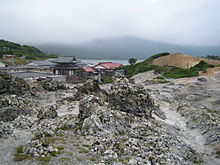Mount Osore
| Bodai-ji 菩提寺 |
|
|---|---|

The temple ground of Bodai-ji
|
|
| Basic information | |
| Location | 3-2 Tanabu Usoriyama, Mutsu, Aomori Prefecture |
| Affiliation | Sōtō Zen |
| Deity | Jizō Bosatsu (Kṣitigarbha) |
| Country | Japan |
| Architectural description | |
| Founder | Ennin |
| Completed | 862 |
Mount Osore (恐山 Osore-zan?) is a caldera volcano in the center of remote Shimokita Peninsula of Aomori Prefecture, Japan. According to the Smithsonian National Museum of National History, it peaks at 879 meters (or 2,884 feet) and its last eruption was noted in 1787 (Global). While known regionally as Mount Osore, it is locally referred to as Yake-yama (or “Burning Mountain”) due to minimal activity which occurred throughout the past century. According to WAttention website, this site was established as a place of reverence by Jikakutaishi, a Buddhist monk, in 862 AD.
According to Japanese mythology, Mount Osore (literally "Mount Fear") marks the entrance to Hell, with a small brook running to the neighboring Lake Usori that is equated to the Sanzu River, a river that deceased souls needed to cross of their way to the afterlife. The Sanzu River, or “River of Three Crossings,” is believed to be the boundary between the realms of the living and the dead. Based on Buddhist beliefs, depending on how well a person lived their life dictates how easy their transition across the river will be, whether it be via a bridge, ford, or wading through snake-infested waters. There are four alleged Sanzu rivers in Japan; the one located near Mount Osore is the most northern. The area has gained a considerable reputation due to the very volcanically-active site and its charred landscape, which is well known for the blasted rocks covering it and being filled with bubbling pits that are noted for their unearthly hues and noxious fumes. The fumes from these pits are caused by the sulfur fumes emitting from the volcano below, which have helped in adding to the underworld connotation of the site. The site is also said to be guarded by Jizo, the bodhisattva of Hell and guardian of children. Thus, Jizo statues may be found throughout the area. Among the statues, many visitors have presented offerings, also known as nuigurumi. The nuigurumi consists of children's toys, clothes, and stones in attempts to help the departed gain entry to heaven.
...
Wikipedia
